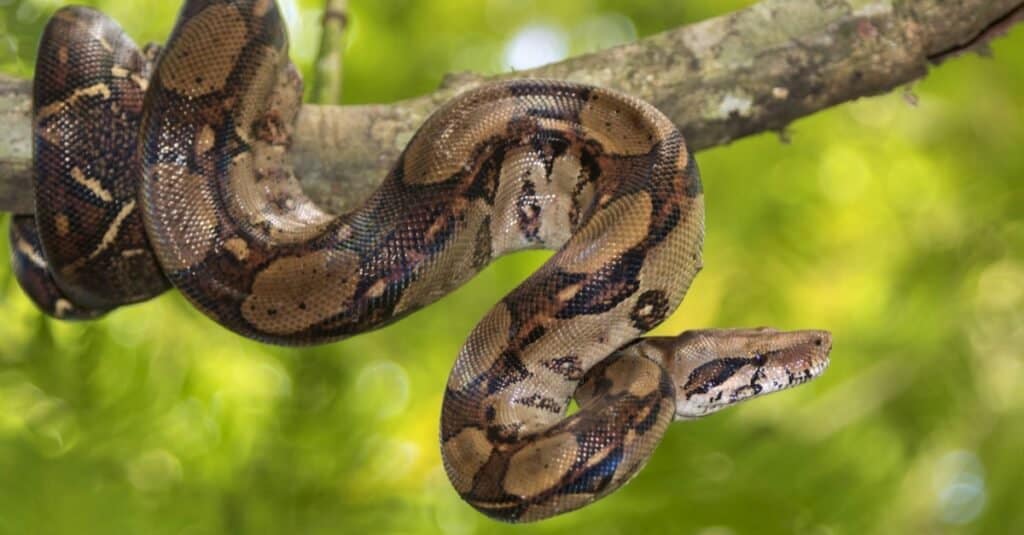Snakes are a popular option for those looking for fairly low-maintenance pets. And there are plenty of options — here are the 10 best pet snake options. Whichever species you land on, there are some general things to keep in mind when it comes to your pet snake. Here’s your pet snake guide to help you get started.
Before Buying a Snake
A snake makes a fascinating pet, but it won’t be a companion animal in the same sense that a dog or a cat may be. Snakes are more to be admired and appreciated than interacted with though certain species can learn to relax while being handled.
Before you bring a snake into your home, keep a few things in mind. First, you will have to set up a habitat for your snake that has both a basking zone and a cooler area, and that’s well humidified. Second, most snakes eat rodents — and they swallow them whole. Finally, snakes grow longer as they get older, sometimes much longer, and you can’t limit the size of a snake by confining it to a smaller enclosure.
Expect to spend anywhere between $15 and $1,000 purchasing your snake and another $350 to $1,300 on the supplies and equipment you’ll need to keep your snake comfortable. Thereafter, plan upon spending $350 a year on snake essentials like food, sphagnum moss, and veterinary bills.

How much Do Pet Snakes Cost — to Buy and to Own
Depending upon the snake species you buy, you can expect to spend between $15 (for a common corn snake) and $1,000 (for an Angolan python). Even with the humble corn snake, however, you can be looking at a range of prices depending upon its color, pattern, and other genetic variations. In snake fancier terms, such variations are called “morphs.” A blue corn snake, for example, may set you back as much as $200.
Never attempt to keep a snake that you or someone else has trapped in the wild. Occasionally, you may find a listing for a free snake from an owner who wants to rehome one, but snakes are not the types of pets you’ll find at the local ASPCA. Your best bet for locating a snake is a reputable breeder or pet store, or at a reptile show.
Purchasing a snake, however, is a relatively small part of the upfront snake ownership costs you are likely to incur.
New Snake Owner Shopping List: What To Buy
Once you’ve identified the snake you wish to purchase, you’ll have to get ready to support your new snake in the manner to which it’s accustomed. For this, you’ll need the following supplies and equipment:
- An enclosure: The ideal snake space is a terrarium with measurements appropriate to the species. A ball python eventually needs at least a 4x2x2, but a Kenyan sand boa can live out its life in a smaller enclosure. Make sure the terrarium has a screened top for ventilation, and make sure that the top is secure because snakes are escape artists who can slither through even the smallest spaces. If you’re thinking of owning more than one snake, make sure to buy each its own tank: Snakes don’t like to share. Snake enclosures can cost anywhere between $100 and $400. Here are the best snake tanks, reviewed and ranked.
- Bedding: Many snake owners like to decorate enclosures with cool-looking rocks, and that’s fine so long as you also supply a bedding substrate. Snakes like to burrow deep and form nests. Aspen or cedar shavings make great bedding materials because they are easy to spot-clean. Remove your snake’s droppings regularly, and change its bedding at least once a month. Excretion processes are highly variable from snake species to snake species, but some snakes defecate as often as every few days. Substrates cost anywhere between $3 and $10.
- Lighting and heating: Climate control is critical to your pet snake’s wellbeing. Snakes are cold-blooded, which means they can’t regulate their own body temperatures. The optimal enclosure contains a basking zone with a temperature appropriate to the species, usually between 85º and 100º Fahrenheit and a cooler zone of about 70° Fahrenheit. Certain snake species will also need ultraviolet light to catalyze the production of vitamin D so that they will be able to absorb calcium from their food. Habitat lighting should be set up to mimic 12 hours of daylight because snakes have sleep cycles just like you do, and constant light can throw that sleep cycle off. Lights and climate control equipment will set you back around $150.
- Thermometer/ hygrometer: To ensure your snake’s climate control system is operating as designed, invest in a thermometer that will measure the habitat’s temperature and a hygrometer that will measure the habitat’s humidity. These items cost $10 to $20.
- A water bowl: Yes, snakes drink, though they don’t drink the same way most other species do. You’ll need to provide your snake with a water bowl that doesn’t tip over easily and that’s easy to clean. Provide your snake with water that isn’t chlorinated. Water bowls for snake run around $10.
- Hides: In the wild, snakes like to burrow under rocks or logs, so you’ll need to provide them with places to hide. It’s best to set up two hides: one on the hotter side of the enclosure and the other on the cooler side. Many people use homemade hides, constructed out of cardboard paper towel rolls or shoeboxes, but these are easily soiled. It only costs $20 to $30 to buy a hide made of plastic, ceramic, or stone. Your snake may also appreciate a hide filled with sphagnum moss when it’s shedding its skin.
- Food: Snakes’ feeding habits vary by species. Most snakes eat live or frozen rodents. A 50-count bag of frozen large mice will cost you about $50.
Ongoing Needs: What You Need to Care For Your Snake
You’ll incur many of the ownership costs upfront when you first acquire a snake. On an ongoing basis, you can expect to spend money on the following things:
- Bedding replacement: $3 to $10 a month.
- Food: Depending upon how often your snake eats, you may spend $5 per month up to $30 and more.
- Veterinary bills: Since snakes cannot be microchipped or vaccinated, most snake owners forgo visits to a veterinarian until they notice their snake is behaving unusually. It’s worth it to look around for a vet who is knowledgeable about snakes; many are not. Snakes should have annual checkups, and a fecal examination (looking for parasites) should be part of that yearly checkup. Expect to spend $100 to $150 a year on vet bills—and more if your vet identifies something wrong with your snake.
The Best Pet Snakes for Beginners
If you’re new to snake ownership, you probably won’t want to start with a reticulated python. Instead, consider these five comparatively user-friendly snakes:
- Corn snakes (Pantherophis guttata): Corn snakes are docile, easy to handle, and come in a variety of gorgeous morphs. They seldom grow longer than 2.5 to 5 feet, and a well-tended corn snake can live 5 to 10 years. A corn snake costs anywhere between $20 to $200 depending upon its morph.
- California kingsnakes (Lampropeltis getula californiae): The California kingsnake got its name because it preys upon rattlesnakes in the wild. These snakes can be a mite nippy, but they can be trained out of that if they are handled enough. Kingsnakes come in a variety of colors, but they can all be purchased for $50 or so. They grow to 3 or 4 feet long, and their average lifespan is 10 to 15 years.
- Garter snakes (Pituophis spp): Garter snakes feed best on a diet of earthworms, gut-loaded crickets, fish, and frogs, so they’re good pets for ophiophilists who are squeamish about frozen mice or rats. They’re extremely docile and typically grow no longer than 4 to 5 feet. However, they can be the smelliest of snakes: Whenever they get stressed, they excrete a foul-smelling musk.
- Rosy boa (Charina trivirgata): Rosy boas come in a variety of attractive morphs and seldom reach more than 3 feet when fully grown. They can live for up to 25 years. They’re docile, and some rosy boa owners swear their pet snakes can recognize them.
- Ball pythons ( Python regius): The most popular pet snake today is probably the ball python. If properly cared for, they can live for more than 30 years. Females can grow to be 5 feet long; males are considerably smaller. Ball pythons have comparatively stringent habitat requirements: Their habitat must contain a place where they can soak, several hides, and lots of clutter.
Resources:
Feeding your Snake
Snakes are obligate carnivores. Moreover, while snakes do have teeth called fangs, these teeth are not specialized for masticating food. Therefore, snakes swallow their food whole. Their specific diet depends upon their species, but prey such as mice and rats will offer most snakes a complete and balanced diet. If you are squeamish about feeding your snake mice and rats then snakes are probably not the pet for you.
Your snake’s age, size, and activity level will determine how often it should be fed. Smaller snakes (and this includes younger snakes) need to eat twice a week; longer snakes typically eat every week or two. Check with your vet for more specifics about your pet snake’s feeding preferences, and check out this article called “How Long Can a Snake Go Without Eating?” for more insight.
Live prey should never be fed to snakes because they may bite your snake and injure it even if your snake succeeds in eating them. Offer your snake the meal. Some snakes prefer it when you dangle the food in front of them since this simulates the movement of prey in the wild; others prefer you to put it on a plate. If the snake eats, then it is hungry; if it doesn’t eat, either it is not hungry, or something else may be going on. Snakes typically lose their appetites when they’re shedding their skins or some aspect of their habitat is causing them stress. Appetite loss may also be linked to more serious causes such as parasites, kidney failure, or other health-related things.
How Long Will Your Snake Live?
In the wild where they face predators, snakes typically live 2 to 8 years. As pets, however, snakes can be expected to live 15 to 30 years. The exact lifespan will depend upon what species your snake is.
Common Health Issues For Snakes
Pet snakes can be affected by several common health issues, including:
- Mouth rot: One of the most dependable ways to know if your pet snake has a health-related issue is to examine its mouth for the presence of infectious stomatitis also known as “mouth rot”. A snake with mouth rot will have pinprick hemorrhages on its gum or oral secretions that look like cottage cheese. Mouth rot can be a sign that your pet’s diet is not providing it with ample nutrition or that it has a more serious underlying condition.
- Parasites: Snakes in captivity can suffer from both external parasites like mites and fleas, and internal parasites like intestinal worms. This is why it’s important to get your snake’s stool checked on an annual basis since snakes with parasites may seem asymptomatic to you even though they are suffering.
- Skin infections: Snakes that are kept in conditions that are either too dry or too damp may develop inflamed skin with blister-like lesions, particularly on their undersides.
- Respiratory infections: Respiratory infections in snakes are typically accompanied by stomatitis. Snakes will lose their appetites and seem lethargic. With some snakes, you may n even hear wheezing sounds as they struggle to breathe.
Where to Buy your Snake
The best places to purchase your pet snake are:
- Pet stores: The Big Box pet stores are great places for people new to snake owning to buy their first pet. You will pay a competitive price, and you can assume the snake has been well cared for before it comes home with you. Smaller pet stores can also be good options if you know something about the store’s reputation.
- Reptile shows: Many cities have annual reptile and exotic pet expos where breeders and fanciers from a relatively large geographical area congregate. Reptile shows can be good places to shop for pet snakes, particularly if you’re interested in owning a relatively rare species.
- Breeders: Unless you are a genuine snake aficionado, it’s probably best to avoid snake breeders Their attention to detail is way beyond what a snake newbie can appreciate, and their prices are commensurate.
Shedding in Snakes
One of the most fascinating things about snakes is the way they shed their skins. You shed your skin, too, by the way, but you do so in tiny aliquots over a very long period. Snakes shed their skins all at once. The scientific name for this process is “ecdysis,” and it happens 4 to 12 times a year.
Before your snake is ready to shed its skin, it grows reclusive. It may spend more time in its hides, and it will lose its appetite. Its eyes may become cloudy; this is because there are scales on its eyes that will be sloughed along with the rest of its skin.
The complete shedding process typically takes between one and two weeks. Avoid handling your snake during this time. If you want to help the shedding process along, put a basin of water in its habitat and provide some coarse materials such as rocks and tree branches.
If ecdysis proceeds smoothly, your snake will shed its skin in one long tubular piece. If your snake has not completely shed its skin after two weeks, then it’s time for a visit to the vet.
Pet Snake Guide: What You Need To Know FAQs (Frequently Asked Questions)
How long can a snake get?
In the wild, anacondas and boas can grow up to 30 feet long. Most pet snakes seldom grow more than 5 feet long though some pet boas and pythons have hit the 9-foot mark.
When do snakes sleep?
A healthy snake can sleep up to 16 hours a day. Most snakes are nocturnal, so they sleep during the daytime and prowl around at night.
Can you tame a snake?
Not really. Snakes can’t be domesticated in the same way that dogs, cats and even birds can be domesticated. If you handle your snake a lot, in time it will get used to your touch and come to view you as a safe thing. Once that happens, it will relax around you. That’s not the quite thing as being tame, though.
Does it hurt snakes to shed their skin?
Snakes jumpstart the shedding process by rubbing up against hard surfaces like rocks or tree branches. The entire process lasts between 1 and 2 weeks, and the process does appear to be physically uncomfortable for them.
What do snakes eat?
Most snakes eat a diet consisting of small rodents.
Can snakes hear?
Snakes don’t have any external ear structures, but they do have ear bones that enable them to register acoustic vibrations in a relatively narrow range of frequencies. Some human voices are within that range of frequencies.
Do snakes recognize their owners?
Snakes have a good sense of smell and some ability to hear, so yes, they probably do recognize (and remember) their owners. This is not quite the same thing as bonding with their owners, however.
How often do snakes go to the bathroom?
Snakes’ excretion processes vary widely from species to species. Some snakes defecate every three days while others can go for three months between excretions. Many snakes defecate one week to 10 days after they eat.
Are serpents and snakes the same thing?
Yes, snakes and serpents are the same things.
Thank you for reading! Have some feedback for us? Contact the AZ Animals editorial team.




